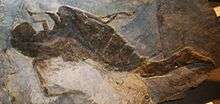Jaekelopterus
| Jaekelopterus Temporal range: Middle Devonian, 390 Ma | |
|---|---|
 | |
| Fossil of Jaekelopterus | |
| Scientific classification | |
| Kingdom: | Animalia |
| Phylum: | Arthropoda |
| Subphylum: | Chelicerata |
| Class: | Merostomata |
| Order: | †Eurypterida |
| Superfamily: | †Pterygotioidea |
| Family: | †Pterygotidae |
| Genus: | †Jaekelopterus (Jaekel, 1914) |
| Type species | |
| Jaekelopterus rhenaniae Waterston, 1964 | |
| Species | |
| |
Jaekelopterus ("Otto Jaekel's wing) is an extinct genus of sea scorpion. Jaekelopterus lived approximately 390 million years ago. At an estimated length of 2.5 metres (8.2 ft), it is the largest known arthropod ever discovered, surpassing the Pterygotus and even the millipede-like Arthropleura. There are two species, one being the type species, J. rhenaniae, from freshwater strata in the Rhineland, and J. howelli from estuarine strata in Wyoming.[1]
Description

Jaekelopterus is currently the largest known eurypterid and the largest known arthropod. The J. rhenaniae claw was found near Prüm in Germany. To work out the size of the arthropod it belonged to, Braddy and colleagues collected information on closely related sea scorpions and the ratio between their claw size and body length. This turned out to be relatively constant, leading the researchers to conclude that a creature with a 46-centimetre claw probably had a body length between 233–259 cm (7 ft 8 in–8 ft 6 in) (246 cm (8 ft 1 in) on average).[2] When extended, the chelicerae would have added another 1 metre (3.3 ft) to its length.[2]
Discovery
Although Jaekelopterus is called a "sea scorpion", the strata in which it was found suggest that the living animal dwelled in fresh-water systems and estuaries, rather than in marine environments proper. The animal was described in November 2007 by Simon Braddy and Markus Poschmann of the University of Bristol in the journal Biology Letters: they found a 46-centimetre (18 in) chelicera (claw-like mouth part), and estimated the total size of the animal based on the proportions of this claw.[2][3][Note 1]
The holotype of J. rhenaniae was discovered in the early Middle Devonian (Eifelian) Klerf Formation Lagerstätte of Willwerath near Prüm, Germany.[4][5]
Habitat
Jaekelopterus lived in freshwater lakes and rivers and probably never ventured into the ocean. The animal would have been the top predator of its environment, preying on anything it could catch such as fish and other arthropods.[6][7]
See also
Notes
- ↑ The maxim Ex pede Herculem expresses this principle of proportionality.
References
-
 Data related to Jaekelopterus at Wikispecies
Data related to Jaekelopterus at Wikispecies
- ↑ James C. Lamsdell and Paul A Selden (2013). "Babes in the wood – a unique window into sea scorpion ontogeny". BMC Evolutionary Biology. 13: 98. doi:10.1186/1471-2148-13-98.
- 1 2 3 Braddy, Simon J.; Poschmann, Markus; Tetlie, O. Erik (2007). "Giant claw reveals the largest ever arthropod". Biology Letters. 4 (1): 106–109. doi:10.1098/rsbl.2007.0491. PMC 2412931
 . PMID 18029297.
. PMID 18029297. - ↑ Cressey, Daniel (November 21, 2007). "Giant sea scorpion discovered". Nature. doi:10.1038/news.2007.272. Retrieved June 10, 2013.
- ↑ "Giant sea scorpion claw unearthed". BBC News. November 21, 2007. Retrieved June 9, 2013.
- ↑ Khamsi, Roxanne (November 21, 2007). "Giant claw points to monster sea scorpion". New Scientist.
- ↑ http://www.nature.com/news/2007/071120/full/news.2007.272.html
- ↑ Pepper, www.prehistoric-wildlife.com, Darren. "Jaekelopterus".
External links
![]() Media related to Jaekelopterus at Wikimedia Commons
Media related to Jaekelopterus at Wikimedia Commons